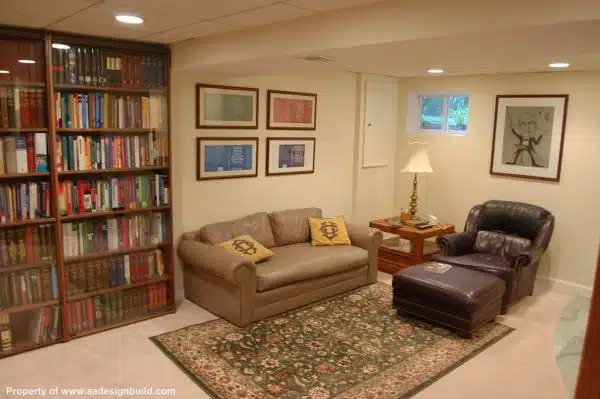As a home design and interior decorating expert, I have observed that the way people choose to decorate their homes often reflects how they express love in their personal relationships. Your home is an extension of your personality, and everything from the colors you choose to the furniture you pick says something about your character and values. In this article, we will explore what your home design says about how you love.
Many people are unaware of the subconscious messages they send through their home design choices. For example, someone who decorates with bold and bright colors may be perceived as outgoing and adventurous, while someone who prefers muted tones might be seen as more reserved and introspective. Likewise, the way you arrange your furniture can hint at whether you prioritize intimacy or individual space in your relationships. By understanding these subtle cues, we can learn more about ourselves and our loved ones, strengthening our connections and communication.
The Psychology Of Home Design
They say that home is where the heart is, and there’s a reason for that. Our homes are a reflection of ourselves, our personalities, and our values. It’s not just about aesthetics, but also about intrinsic motivations and cultural influences that shape our preferences in home design. As an expert in interior decorating, I’ve seen firsthand how people express themselves through their living spaces.
Intrinsic motivations play a significant role in home design choices. People often gravitate towards designs that make them feel comfortable and happy. This could be anything from warm colors to cozy textures or even sentimental objects. It’s essential to create a space that feels like your own and reflects your personality because it can have a positive impact on your mental health.
Cultural influences also impact home design choices. Depending on where you live or what culture you identify with, you may have different ideas of what constitutes a beautiful home. For example, Scandinavian design emphasizes minimalism, while Mediterranean-inspired homes might feature bright colors and intricate patterns. These cultural influences can be subtle or explicit but ultimately add another layer of meaning to our home design choices.
As we move into the next section about the influence of personality on design choices, it’s important to remember that both intrinsic motivations and cultural influences inform how we decorate our homes. Home design is more than just aesthetics; it’s an expression of who we are as individuals and members of society.
The Influence Of Personality On Design Choices
Modern minimalism is a popular choice in home design due to its ability to create a peaceful atmosphere that is free of clutter. The use of neutral colors and simple patterns are often employed to create a sense of balance in the home. Color psychology is an important factor to consider when designing a home as the colors chosen can evoke certain emotions and feelings in the inhabitants. When selecting a style for a home, it is important to consider the preferences of those who live there as their individual style will have a great influence in the overall design. For example, a modern style may be preferred by those who enjoy minimalism while a more traditional style may be desired by those who enjoy a classic feel. Furthermore, the materials and textures used in the design should also reflect the occupants’ style. Ultimately, the design choices should be a reflection of the homeowner’s personality and style.
Modern Minimalism
The modern minimalist home design trend has been growing in popularity in recent years. This design style is characterized by the use of clean lines, simple forms, and neutral colors. Maximizing space and incorporating technology are also important aspects of this style. By eliminating clutter and unnecessary elements, modern minimalism creates a sense of calm and order within a space.
Balancing simplicity with adding character is key to achieving a successful modern minimalist design. While the focus may be on simplicity, it’s important to incorporate unique touches that reflect the homeowner’s personality and style. This can be achieved through the use of statement pieces such as artwork or carefully selected furniture items that add interest without cluttering the space.
Overall, modern minimalism offers a sophisticated and practical approach to home design. It’s ideal for those who value functionality and efficiency without sacrificing style. Incorporating technology and maximizing space are just some of the ways this design style helps homeowners create a comfortable living environment while maintaining an uncluttered aesthetic.
Color Psychology
The influence of personality on design choices can be seen in the selection of colors used within a home. The psychology of color plays an important role in how it affects mood and behavior, making it essential for homeowners to choose colors that reflect their personality and enhance their overall well-being. For example, those who prefer a calming atmosphere may opt for neutral colors such as beige or gray, while those who desire a more energizing space may choose bold shades like red or yellow.
In addition to personal preferences, cultural influences also play a significant role in home decor. Incorporating traditions and customs into design choices can add depth and meaning to a space. This can be achieved through the use of cultural artifacts or incorporating traditional patterns and textiles into the design. By doing so, homeowners can create a space that reflects their heritage and values while still adhering to modern minimalist principles.
When designing with color psychology in mind, it’s important to keep in mind that there are no hard and fast rules. Ultimately, the most successful designs are those that balance personal style with practicality. Whether using bold hues or subtle tones, creating a space that feels welcoming and comfortable is key to achieving a successful modern minimalist design.
Style Preferences
When it comes to designing a home that reflects one’s personality, style preferences play an important role. The way people dress and decorate their homes is often a reflection of who they are and what they value. Using cultural influences to inspire design choices can be particularly useful in creating a space that feels authentic and meaningful. However, gender and design preferences can also play a significant role in shaping one’s personal style.
For example, studies have found that women tend to prefer softer colors such as pastels and neutrals, while men often opt for bolder hues like black or red. This may reflect broader societal expectations around gender norms, but it also highlights the importance of understanding individual design preferences when creating a space that feels comfortable and welcoming. Ultimately, the goal is to find a balance between personal taste and practical considerations such as functionality and accessibility.
When it comes to modern minimalist design, individuals with different style preferences can still find ways to incorporate their unique tastes into their homes. For instance, those who prefer more traditional styles may opt for muted tones or classic patterns, while those who enjoy contemporary designs might choose clean lines and geometric shapes. By taking the time to understand one’s design preferences and incorporating them into a modern minimalist aesthetic, homeowners can create a space that truly reflects who they are.
Using Color To Express Emotions
As we have discussed in the previous section, our personality heavily influences our design choices. However, another factor that can reveal a lot about how we love is the color scheme of our home. Colors have a profound impact on our mood and emotions, and choosing the right colors can enhance productivity or promote relaxation.
Using color to enhance productivity involves selecting shades that inspire energy and focus. Bright colors like reds, yellows, and oranges are known to increase adrenaline levels and stimulate creativity. These hues work best in spaces where you need to be productive, such as a home office or art room. On the other hand, using calming colors like blues, greens, and purples can help promote relaxation. These shades are perfect for creating a serene atmosphere in bedrooms or bathrooms.
It’s important to note that color is not one-size-fits-all when it comes to creating mood. Personal preference plays a significant role in determining which shades evoke certain emotions. Consider experimenting with different hues until you find the perfect match for your space. In the next section, we will explore another crucial element of interior design – lighting – and how it can also affect our emotions and well-being within a space.
The Power Of Lighting In Creating Mood
Lighting design is a crucial element in creating the desired mood in any space. Lighting can make or break the vibe of a room, and it is essential to choose the right type of lighting for your home. Using lighting to enhance mood involves more than simply illuminating a space; it requires careful consideration of various lighting techniques. For instance, ambient lighting creates an inviting and warm atmosphere, while task lighting is ideal for focused activities such as reading or working.
Natural light has been shown to have a significant impact on emotions. Exposure to natural light can improve mood, increase productivity, and reduce stress levels. In contrast, artificial light can cause headaches and eyestrain while also negatively impacting one’s emotional state. Therefore, it is critical to incorporate natural light into your home design wherever possible. Large windows that allow plenty of natural light are ideal for creating an uplifting atmosphere.
Incorporating lighting into home design can significantly influence the way people feel about their living spaces. By choosing the right type of lighting, you can create an environment that promotes relaxation and happiness. Lighting should be used strategically to highlight specific elements in the room while also providing general illumination throughout the space. The power of lighting cannot be overemphasized as it impacts not only our mood but also our overall health and wellbeing.
The placement of furniture in your home reflects relationship dynamics between family members or housemates. Furniture arrangement affects how people interact with each other within a particular space. Consequently, understanding how furniture placement affects relationships is vital when designing and decorating homes. Through strategic furniture placement, you can encourage communication, create intimacy between people in a room or promote privacy where necessary without compromising functionality or aesthetics.
How Furniture Placement Reflects Relationship Dynamics
As the old saying goes, “the way you arrange your furniture says a lot about how you love.” Furniture arrangement can reveal a lot about a couple’s relationship dynamic. It is an aspect of design that is often overlooked, but it can have a significant impact on the mood and atmosphere of a home. Whether it be large or small, the placement of furniture in a room can reflect how intimate or individualistic the space is.
Furniture arrangement can either enhance or hinder intimacy in design. For instance, if two people are in a strong, committed relationship, they may choose to arrange their furniture so that it promotes closeness and comfort. In contrast, couples who value personal space may opt for more individualistic arrangements. It is important to note that there is no right or wrong way to arrange furniture; it all depends on what works best for each individual couple.
Personal space and intimacy in design are not mutually exclusive concepts. A well-designed space should strike a balance between both elements. Couples who prioritize personal space should consider incorporating separate seating areas into their living rooms or bedrooms. Conversely, those who value intimacy may want to invest in larger pieces of furniture that encourage snuggling and bonding time together. Ultimately, communication between partners is key when deciding on furniture placement and creating a space that reflects their unique relationship dynamic.
Decorating for intimacy vs. individual space requires careful thought and planning. Each couple has different needs and preferences when it comes to their living spaces. By paying attention to the placement of furniture and choosing pieces that promote closeness or personal space as necessary, couples can create an environment that enhances their unique relationship dynamic while still feeling comfortable and inviting.
Decorating For Intimacy Vs. Individual Space
In home decor, there is often a struggle between balancing privacy and togetherness. It can be challenging to create a design that caters to both individual space and intimate gatherings. However, with careful planning and attention to detail, it is possible to achieve a balance that satisfies all members of the household.
When decorating for intimacy, it’s essential to consider the layout of shared living spaces. For example, arranging furniture in a way that promotes conversation encourages interaction among family members or guests. Additionally, incorporating soft textures like plush pillows or cozy throws can make a room feel more inviting and conducive to intimate conversations.
On the other hand, when designing for individual space, privacy should be prioritized. This can be achieved by creating designated areas for relaxation or work that offer seclusion from the rest of the household. Simple solutions like adding curtains or installing bookshelves as room dividers can provide much-needed privacy while maintaining an open floor plan.
- Incorporating sentimental objects into your design allows you to create a space that feels uniquely personal while still catering to shared living spaces.
- Displaying family photos or heirloom pieces adds warmth and personality without sacrificing style.
- Incorporating artwork or travel mementos can showcase individual taste while still promoting conversation among family members or guests.
- Utilizing color schemes that reflect personal preferences within shared spaces creates a sense of belonging and ownership for each member of the household.
Overall, achieving a balance between personal taste and shared living spaces requires thoughtful consideration of each household member’s needs and desires. By prioritizing privacy where necessary and incorporating sentimental objects into your design, you can create an environment that fosters both individuality and social connection.
Incorporating Sentimental Objects Into Your Design
The key to creating a home design that truly reflects your personality and values is by incorporating personal mementos and sentimental objects in your decor. These items can serve as reminders of cherished memories or loved ones, adding a deeper layer of meaning to your living space. Whether you choose to use family heirlooms as decor or display travel souvenirs, these elements will make your home feel uniquely yours.
When blending different design styles for couples, incorporating sentimental objects can help create a cohesive look while still honoring each individual’s personal style. For example, if one partner loves rustic decor and the other prefers modern, using DIY projects for a personalized touch can be a great compromise. Consider displaying artwork that evokes emotions or infusing cultural elements in the design to add depth and interest.
In addition to creating a visually appealing space, incorporating sentimental objects can also help create a romantic atmosphere with decor. By adding touches like framed love letters or vintage photographs of ancestors’ weddings, you can cultivate an environment that celebrates love and history. Infusing small details like this can make all the difference in creating a warm and inviting space that truly feels like home.
As we have seen, incorporating sentimental objects into your design is essential in creating a space that reflects your personality and values. By using family heirlooms as decor or displaying travel souvenirs, you can add depth and meaning to your living space while maintaining its visual appeal. In the subsequent section, we will explore the role of texture in creating comfort within our homes.
The Role Of Texture In Creating Comfort
Textures play a significant role in creating comfort in your home. Texture can be defined as the tactile quality of a surface, and it can make a room feel warm and inviting. Using texture to reflect personal values is an excellent way to personalize your space.
To incorporate different textures for different rooms, you’ll need to select materials that are appropriate for each space’s function. For example, if you’re designing a bedroom, you might want to use soft textures like plush blankets or fluffy pillows. In contrast, if you’re designing a home office, harder surfaces like wood or metal may be more appropriate.
Incorporating texture into your home design is an essential aspect of creating a comfortable living space. Whether it’s through the selection of furniture or accent pieces, incorporating texture adds depth and warmth to any room in your house. By using different textures throughout your home, you can create a unique atmosphere that reflects your personality and values. The next section will delve into balancing form and function in your home design while still keeping comfort at the forefront of your mind.
Balancing Form And Function In Your Home
As a professional in home design and interior decorating, I understand the importance of balancing form and function in creating a space that truly reflects how you love. It’s not enough for a room to look aesthetically pleasing; it must also serve its intended purpose. This is where designing for accessibility and creating a multi-functional space come into play.
Designing for accessibility means making sure that your home is accommodating to everyone who may enter it, regardless of their physical abilities. This can include things like wider doorways, lower countertops, and strategically placed grab bars. By incorporating these features into your home design, you are showing that you prioritize the comfort and safety of all those who visit or reside there.
Creating a multi-functional space is another way to balance form and function in your home. A room should not be limited to one purpose; instead, it should adapt to meet the needs of different activities throughout the day. For example, a living room can double as an office space by adding a desk and bookshelves. By doing this, you are maximizing the use of your home while still maintaining its aesthetic appeal.
Incorporating both accessibility and multi-functionality into your home design shows that you value both form and function equally. However, there is another aspect of home design that should not be overlooked: eco-friendly design and values. Let’s take a closer look at how this can also reflect how you love in the subsequent section.
Eco-Friendly Design And Values
The demand for sustainable homes is on the rise, and eco-friendly design has become a crucial consideration in home decor. Sustainable materials play a vital role in this approach. Materials that are renewable, recyclable, or biodegradable are highly sought after by homeowners who prioritize environmentally conscious living. From bamboo to reclaimed wood, these materials can be used in various forms to create an aesthetic that promotes sustainability.
Another essential aspect of eco-friendly design is energy efficiency. By designing homes with energy-efficient features such as solar panels, smart thermostats, and LED lighting, homeowners can save money on utility bills and reduce their carbon footprint at the same time. Mindful consumption is also integral to this approach. Rather than buying new pieces every season, investing in quality items that stand the test of time is key to reducing waste.
In summary, eco-friendly design considers both aesthetic appeal and environmental impact. Using sustainable materials and implementing energy-efficient features are key components of creating a home that aligns with one’s values. Mindful consumption habits also play a significant role in reducing waste while promoting an eco-conscious lifestyle. In the following section, we will explore how textiles can help create a cozy atmosphere while staying true to sustainable principles.
Creating A Cozy Atmosphere With Textiles
- Creating a cozy atmosphere with textiles involves a careful balance of mixing fabrics, selecting a color palette, and varying textures.
- Properly mixing fabrics helps to create a pleasing aesthetic, while coordinating colors and textures provide a sense of harmony.
- Achieving balance with fabrics can be done by combining different materials, such as linen, velvet, and leather, to create a unique look.
- Color palettes should be selected to match the overall desired mood and style of the room. Warmer colors, such as red, orange, and yellow, can create a cozy atmosphere.
- Texture variation is important to create visual interest and depth. Textiles such as wool, fur, and cotton can be used to create a layered and tactile look.
- Incorporating these elements of fabric, color, and texture into your home design can help to create a cozy and inviting atmosphere.
Mixing Fabrics
As a home design and interior decorating expert, I understand the importance of textiles in creating a cozy atmosphere. Mixing fabrics can add depth and intrigue to any room, but it requires careful consideration. When mixing fabrics, it’s important to balance patterns with solids. Contrasting patterns can create visual interest, while coordinating patterns can create a cohesive look. Similarly, contrasting textures and weights can add dimension to a space.
Layering and draping fabrics is another way to create a cozy atmosphere. Layering different textures and patterns adds depth to a room while also providing warmth and comfort. Draping soft blankets over couches or chairs can also add an inviting touch to any living space. It’s essential to keep in mind the overall color scheme when layering and draping fabrics. Coordinating colors will ensure that the different fabrics work together harmoniously.
Incorporating multiple fabrics into your home’s design requires attention to detail and careful planning. The key to successful fabric mixing is finding the right balance between contrasting and coordinating elements, as well as layering and draping textures for added warmth and depth. With these tips in mind, you can create a cozy atmosphere that reflects how much you love serving those who enter your home.
Color Palette
In addition to mixing fabrics, the color palette plays an essential role in creating a cozy atmosphere with textiles. Combining colors requires a basic understanding of color theory. The right combination of colors can transform a room into a warm and inviting space.
When selecting colors for your home’s design, it’s important to consider the mood you want to create. Warm tones like reds, oranges, and yellows can add energy and coziness to a room. On the other hand, cool tones like blues, greens, and purples can create a calming atmosphere. Neutral tones such as beige, gray, or white can serve as a base for any color scheme.
Using color theory is also crucial when combining patterns and textures. Patterns that share similar hues or complementary colors can work together harmoniously. However, if you’re looking to create visual interest in a space, contrasting colors can add depth and drama.
By thoughtfully incorporating color into your home’s design with textiles, you can create a cozy atmosphere that reflects your desire to serve others who enter your space. With an understanding of color theory and careful consideration of your desired mood and style, combining colors will become second nature in no time.
Texture Variation
As an expert in home design and interior decorating, I understand that using texture in minimalistic design is crucial to creating a cozy atmosphere with textiles. Texture variation can add depth and dimension to a space, making it more visually interesting and inviting. When combined with color theory, texture variation can create a harmonious and balanced environment that serves the needs of those who enter the space.
Incorporating natural textures is one way to achieve a cozy feel in your home’s design. Textures such as wood, leather, wool, and linen can add warmth and comfort to any room. Natural textures also bring a sense of calmness and grounding to a space, making it more inviting for guests. By strategically incorporating natural textures into your home’s design through textiles like blankets, pillows, curtains, or area rugs, you can create a cozy atmosphere that reflects your desire to serve others.
When combining texture variation with color theory in your home’s design through textiles, it’s essential to consider the mood you want to create. Smooth and shiny textures like silk or satin can add elegance or glamour to a space while rougher textures like burlap or jute can create a rustic feel. Mixing different textures can help balance out the overall aesthetic of the room while adding tactile interest for visitors. By thoughtfully incorporating texture variation into your home’s design through textiles, you can create a warm and inviting atmosphere that will make everyone feel right at home.
Minimalism And Its Impact On Relationships
Like a blank canvas, minimalist homes are simple and unadorned, allowing their occupants to fill the space with their own personalities. Minimalist relationships follow the same principle, stripping away unnecessary distractions to focus on what truly matters. These relationships prioritize quality time over material possessions and value experiences over things.
However, there are downsides to decluttering. Emotions can be hidden behind a lack of physical objects, leading to a lack of emotional connection between partners. Without tangible reminders of shared memories or affectionate gestures, it can be difficult for couples to feel emotionally connected. Additionally, the pressure to maintain a pristine home can lead to stress and anxiety within the relationship.
Despite these challenges, minimalist relationships can thrive with intentional effort. By intentionally creating meaningful moments and incorporating sentimental objects into their home design, couples can foster emotional connection while still enjoying the benefits of minimalism. The key is finding balance between simplicity and sentimentality.
As an expert in home design and interior decorating, I have seen firsthand how art and design intersect in shaping relationships. Art has the power to evoke emotions and create connections between individuals. Incorporating art into minimalist homes can add depth and personality without sacrificing simplicity. By carefully curating pieces that hold personal significance or choosing pieces that inspire joy or curiosity, couples can enhance their home environment while strengthening their bond with one another.
The Intersection Of Art And Design
Exploring creativity is an essential aspect of designing a home that reflects how you love. Art and design intersect in various ways, and it is crucial to find the perfect balance between the two. Incorporating art into your interior decoration can bring a touch of originality to your living space. It can also serve as a source of inspiration for your home design.
Finding inspiration for your home design can come from anywhere; it could be from nature, fashion, or even other cultures. The critical thing is to stay open-minded and let your imagination run wild. Experiment with different colors, textures, patterns, and materials to create a unique space that represents you and your loved ones.
Incorporating art into your home design not only adds an aesthetic appeal but also creates an emotional connection between you and the space. It is necessary to take time to consider what pieces of art resonate with you emotionally. Once you have found the perfect art piece that speaks to you, then it’s time to incorporate it into your interior decoration in a way that complements the overall theme of your space.
As we explore creativity in our interior decoration choices, we must consider designing for different stages of life and love. Designing for different stages requires understanding how people evolve throughout their lives and how their needs change over time. In the next section, we will discuss ways to design homes that cater to these changes without sacrificing style or aesthetics.
Designing For Different Stages Of Life And Love
Designing a home that caters to the needs of a multi generational household can be challenging yet rewarding. The key is to think about functionality and accessibility when planning your design. For instance, incorporating wider doorways and staircases, handrails, and non-slip flooring can make the space more accessible for elderly family members or those with disabilities.
Another aspect to consider when designing for different stages of life is incorporating cultural elements into your home decor. For example, if you have family members from different cultures, you may want to incorporate artifacts or art pieces that reflect their heritage. This not only adds a unique element to your design but also creates an environment that celebrates diversity and promotes unity.
Designing a home for different stages of love requires careful consideration of each partner’s preferences. Understanding your partner’s design style can help you strike a balance between aesthetics and practicality in your home decor. In the next section, we will explore how to identify different design styles and incorporate them into your home decor seamlessly.
Understanding Your Partner’s Design Style
Designing a home that reflects both partners’ personalities and preferences can be a daunting task. It is crucial to understand your partner’s design style to create a cohesive and harmonious space. By doing so, you will not only have a beautiful home but also show how much you appreciate and respect each other’s tastes.
Recognizing design conflicts is the first step in understanding your partner’s design style. It is essential to identify areas of disagreement early on in the process to avoid arguments later. Take the time to listen to each other’s ideas and communicate your concerns calmly. These conversations are an opportunity for designing compromises that reflect both of your styles and personalities.
Once you have identified any potential conflicts, it is time to delve deeper into your partner’s design style. There are three sub-lists that can help you better understand their preferences:
- Colors: Pay attention to the colors they gravitate towards in clothing or accessories, as this may indicate what colors they prefer in their living space.
- Textures: Observe whether your partner prefers soft or rough textures and incorporate them into the design elements such as rugs or cushions.
- Furniture: Look at their current furniture pieces for clues about their preferred style, whether it be modern, traditional, or somewhere in between.
By following these steps, you can gain a better understanding of your partner’s design style and create a beautiful home together. Remember that designing compromises are essential for creating a space where both partners feel comfortable and happy with the result.
Conclusion
As a home design and interior decorating expert, it is clear that our homes reflect who we are and how we love. The psychology of home design reveals the influence of personality on design choices, including the use of color to express emotions and the power of lighting in creating mood. Furniture placement also reflects relationship dynamics, while minimalism can impact relationships.
Art and design intersect at every turn, offering opportunities to express individuality and creativity. Designing for different stages of life and love requires careful consideration to ensure the space is functional and aesthetically pleasing. Understanding your partner’s design style is essential for creating a harmonious living environment that speaks to both of you.
In conclusion, our homes are more than just physical structures; they are extensions of ourselves. Every decision we make about design reflects our personality traits, emotions, and relationship dynamics. By understanding how our homes speak to us and others, we can create spaces that promote positivity, harmony, and love. Let your home be a reflection of your heart!
Image Credits
- “www.aadesignbuild.com, Finished Basement, Design and Remodeling, Home Library, Music Center, Bar, Powder Room, Interior Design, Lighting, Aging in Place” by A&A Design Build Remodeling, Inc. (featured)




























